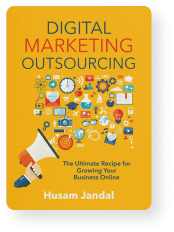 You’ve probably seen lots of marketing advice that tells you exactly what to say, how often to say it, and where. However, effective marketing doesn’t begin with saying anything. If you want lasting results, your marketing strategy starts with listening. Give me a few minutes, and I’ll walk you through why listening is essential and how to develop a listening-led marketing strategy.
You’ve probably seen lots of marketing advice that tells you exactly what to say, how often to say it, and where. However, effective marketing doesn’t begin with saying anything. If you want lasting results, your marketing strategy starts with listening. Give me a few minutes, and I’ll walk you through why listening is essential and how to develop a listening-led marketing strategy.
Every Strong Marketing Strategy Starts with Listening
Tuning into your customers before speaking helps you build a stronger company from the ground up.
Listening to the Voice of the Customer Leads to Higher Profits and Growth
Customer-centric companies consistently outperform those that focus only inward. In fact, companies that actively listen and respond to their customers are 60 percent more profitable than those that don’t emphasize customer feedback, according to Deloitte.
Listening Protects You from Costly Mistakes
Businesses that overlook listening often spend money solving problems their customers don’t have. Take Blockbuster, for example. It wasn’t just streaming technology that brought the company down. It was their decision to overlook how people’s viewing habits and desires were changing. By failing to listen, they missed crucial signals their market was sending.
You Strengthen Customer Loyalty
When you listen to your customers, they feel valued. A valued customer is far more likely to remain loyal, refer your brand, and advocate on your behalf. In short, the best listeners become brands people don’t want to leave.
You Can Create More Effective Marketing Messages
By listening carefully, you uncover your customers’ exact needs, preferences, and language. This insight helps you speak clearly and compellingly in your marketing. You’ll never again guess if your messages resonate; your customers have already shown you precisely what matters.
Listening Helps You Innovate Faster and Smarter
Your customers can spot opportunities you haven’t imagined yet. Whether it’s an unmet need or an unexpected use for your product, paying attention helps you innovate in ways that genuinely matter.
Methods of Listening and Tools for Listening-Led Marketing

When you decide to make customer listening a cornerstone of your marketing strategy, your first instinct might be to set up a social media monitoring tool and call it a day. But social listening is just one way to understand your customers. Effective listening happens in many places, using various methods and tools.
Direct Feedback Methods
Direct feedback means proactively asking your customers what they think, rather than waiting for them to volunteer information.
- Surveys and Questionnaires: Platforms like SurveyMonkey or Typeform make it easy to quickly gather customer insights. These tools help you measure satisfaction, evaluate product ideas, or gauge interest in new services.
- Interviews and Customer Panels: Sometimes, a face-to-face (or Zoom-to-Zoom) conversation can reveal deeper motivations and needs. Short, informal interviews can uncover powerful insights that surveys miss.
- Reviews and Testimonials: Encourage customers to leave feedback on platforms like Google Reviews or industry-specific sites like Yelp, or Trustpilot. Regularly reviewing and responding to these comments shows that you care and provides insights that you can act on immediately.
Behavioral Listening Methods
Your customers’ actions often speak louder than their words. By looking at what customers do, rather than only what they say, you gain a deeper understanding of their true preferences.
- Website Analytics: Tools like Google Analytics show exactly how visitors interact with your site, including where they linger, where they exit, and what captures their attention.
- Heatmap Tools: Tools like Hotjar or Microsoft Clarity allow you to visualize exactly where visitors click and scroll so you can pinpoint precisely what’s interesting or confusing to your audience.
- Purchase Patterns: Customer buying behavior tracked through platforms like Shopify, WooCommerce, or CRM platforms such as HubSpot can help you understand which products resonate most strongly with customers and what prompts repeat purchases.
Social and Community Listening
Social listening involves tracking conversations and mentions about your brand, competitors, or industry. It also includes paying attention to conversations your customers have online, even when you’re not explicitly mentioned.
- Social Monitoring Tools: Platforms such as Hootsuite, Mention, or Sprout Social aggregate conversations across social media platforms, allowing you to understand sentiment, discover trends, and quickly address customer concerns.
- Forums and Online Communities: Niche forums, Facebook groups, LinkedIn communities, or even Reddit threads where your customers gather can yield deep insights into their real frustrations and desires.
Sales and Customer Support Listening
Your sales and customer support teams have daily conversations with customers. They often hear firsthand what matters most, what questions arise repeatedly, and where misunderstandings or unmet needs exist.
- CRM Systems: Platforms like Salesforce, HubSpot, or Zoho allow sales teams to document customer questions, objections, and feedback, allowing you to create an organized, searchable record of customer interactions.
- Helpdesk Systems: Using tools such as Zendesk or Freshdesk, your support teams can track trends in customer questions, requests, and complaints to help your business address issues before they escalate or become widespread.
Internal Listening
Your own team often has valuable insights into customer needs, frustrations, and opportunities. Internal listening means regularly tapping into the experience of those who interact with your customers.
- Team Check-Ins: Host regularly scheduled meetings to share customer stories, challenges, and trends that can highlight emerging issues or opportunities.
- Cross-Functional Collaboration: Marketing, sales, and customer service teams should regularly share insights, ensuring everyone stays aligned on what’s most important to your customers. Documenting and applying these shared insights can inform a more effective client onboarding process that reinforces consistency across all touchpoints
- Employee Feedback Tools: Platforms like Slack or internal feedback tools encourage team members to easily document observations or ideas as they encounter them.
Third-Party and External Audience Research
Sometimes the best insights come from outside your immediate circle. Industry studies, market reports, and competitor reviews all provide valuable context and benchmarking.
- Industry Reports: Sources like Deloitte, Gartner, or industry-specific research providers give broader context about trends impacting your business.
- Competitor Analysis Tools: Tools such as Semrush or Ahrefs help you identify competitor strategies, customer reactions, and emerging opportunities in your market.
How to Build and Implement a Market Listening Strategy
Building a listening strategy is similar to creating any thoughtful business plan. It begins with clarity, requires intentional choices, and integrates naturally into your existing workflows. Here’s how you can set up and start benefiting from a market listening strategy.
1. Define Clear Objectives
Before jumping into the listening process, pinpoint exactly what you want to achieve. Your goals will shape everything else, including methods, tools, and processes. Consider objectives such as:
- Improving Customer Retention: Understand why customers leave and what could keep them loyal.
- Launching New Products or Services: Learn exactly what customers need or want to see from you next.
- Enhancing Marketing Messages: Identify which messages truly resonate and motivate action.
2. Identify Key Listening Channels

Determine the touchpoints where you can hear and learn from your customers most effectively. These channels should align closely with your objectives. Your key listening channels might include:
- Direct Channels: Surveys, interviews, customer reviews.
- Behavioral Channels: Website analytics, heatmaps, purchasing patterns.
- Social Channels: Social platforms, forums, online communities.
- Sales and Service Channels: Frontline conversations, helpdesk tickets.
- Internal Channels: Sales meetings, team briefings, CRM notes.
- External Channels: Industry reports, competitor analyses.
3. Select Your Tools Thoughtfully
There are countless listening tools available. To select the right ones, consider your team’s size, budget, and ease of integration into your workflows. To recap, this includes:
- Direct Feedback Tools: SurveyMonkey, Typeform.
- Behavioral Analytics: Google Analytics, Hotjar, Microsoft Clarity.
- Social Listening Tools: Mention, Hootsuite, Sprout Social.
- CRM and Helpdesk Platforms: HubSpot, Salesforce, Zendesk.
- Internal Collaboration: Slack, Trello, Monday.com.
- External Research Tools: Semrush, Gartner reports.
4. Assign Ownership and Responsibilities
Clearly define who is responsible for listening, gathering insights, and turning them into actions. Without clear ownership, valuable information risks being overlooked or forgotten. Key roles might include:
- Insights Lead: Coordinates listening activities and gathers feedback across teams.
- Analyst or Marketing Specialist: Turns raw data into actionable recommendations.
- Customer Advocate (sales or service rep): Brings frontline customer perspectives into strategic conversations.
5. Integrate Listening into Existing Workflows
Listening shouldn’t feel like “one more thing” your team has to manage. Instead, embed listening directly into your current business processes:
- Regular Meetings: Add a customer insights segment to sales meetings or team huddles.
- Reporting Cycles: Include insights from listening activities in monthly or quarterly reports.
- Marketing and Sales Planning: Base marketing campaigns or product updates on listening findings.
- CRM Practices: Document and review customer interactions regularly in your CRM platform.
6. Close the Loop and Turn Listening into Action
Listening is most powerful when it leads to visible action. Respond directly to customer feedback and share how their input helped shape decisions with your customers. Actions can include:
- Communicating Changes: Publicly announce when customer feedback drives product improvements.
- Adjusting Messaging: Immediately refine marketing content based on insights from listening.
- Training Staff: Equip teams with insights, helping them better anticipate and address customer needs.
7. Regularly Evaluate and Evolve Your Strategy
Customer needs and expectations continuously evolve. Regularly schedule time on a monthly or quarterly basis to evaluate how well your listening approach works and adjust it as needed.
- Review Goals: Determine if your listening still aligns with business objectives.
- Assess Channels and Tools: Keep what’s effective; improve or replace what’s not working.
- Refine Processes: Streamline integration to reduce friction in your workflows.
Get Help Building a Strategic Marketing Foundation
Listening is a fundamental practice that becomes woven throughout every aspect of your marketing and operations. It’s one of many things I consider as I’m developing digital marketing strategies for my clients. If you’re not leveraging this and other foundational tactics or aren’t getting the results you expect from your digital marketing, let’s talk.
FAQs on Customer Insight Marketing and Listening
Why does marketing need to start with listening?
Listening first helps you deeply understand your audience’s needs, preferences, and motivations. It ensures you deliver messages that resonate, develop products customers actually want, and invest resources effectively. Companies that start with listening typically experience greater customer loyalty, increased retention, and higher profitability.
What does listening mean in a marketing context?
In marketing, listening means proactively collecting and analyzing customer insights to understand their wants, needs, and pain points. It involves monitoring customer conversations, behavior, feedback, and industry trends, then using these insights to shape messaging, product development, and overall strategy.
How do companies listen to their customers effectively?
Effective listening involves a combination of methods like direct surveys, customer interviews, analytics tracking, social media monitoring, and gathering frontline sales or service feedback. Top companies integrate these practices into everyday workflows and decision-making processes, ensuring customer insights consistently guide their strategy.
What tools are used for market or audience listening?
Common listening tools include Google Analytics, Hotjar, SurveyMonkey, Typeform, Mention, Hootsuite, Zendesk, HubSpot, Salesforce, and Microsoft Clarity. These tools help businesses monitor customer behavior, sentiment, and preferences, making it easy to capture, analyze, and act upon customer feedback and insights.
How does listening improve marketing strategy?
Listening ensures your marketing strategy addresses real customer needs. It clarifies your messaging, helps identify new opportunities, reduces wasted marketing spend, and strengthens customer relationships. By continuously incorporating customer insights, your marketing becomes more relevant, engaging, and effective.
What is the voice of customer in marketing?
Voice of customer refers to the direct feedback, opinions, and insights shared by your customers. Capturing the voice of the customer means actively seeking out and analyzing feedback from reviews, surveys, interactions, and online conversations, then using these insights to improve products, services, and marketing strategies.
How do brands turn feedback into marketing insight?
Brands gather feedback through surveys, reviews, and social listening, analyze it for patterns or trends, and then translate findings into actionable insights. These insights directly inform marketing decisions such as messaging improvements, product enhancements, audience segmentation, or new campaign strategies, making marketing more effective.
What’s the difference between hearing and listening in marketing?
Hearing is a passive approach that involves simply acknowledging customer feedback without taking action. Listening, however, is active and purposeful. It involves intentionally seeking customer input, understanding the underlying reasons behind it, and using this understanding to make meaningful strategic decisions that positively impact customers and business outcomes.
Can listening actually increase marketing ROI?
Yes, active listening significantly boosts marketing return on investment. By ensuring messages align with customer needs, you spend budget more efficiently, improving response rates, conversions, and customer retention. Customer-centric companies are 60 percent more profitable than those without active customer listening practices, according to Deloitte.
How do you build listening into your campaign process?
Incorporate listening by defining clear goals, choosing key customer channels, regularly using analytics tools, and sharing insights with your team throughout your campaign. Schedule routine reviews of feedback, and continuously adjust your campaigns based on these real-time customer insights, ensuring maximum relevance and effectiveness.
Why do most marketing strategies fail without listening?
Marketing without listening risks misalignment with customer needs, leading to irrelevant messaging, wasted budgets, and customer dissatisfaction. Companies that overlook listening miss important insights, resulting in poor product fit, failed campaigns, and ultimately lower customer engagement and retention rates.
How do leading brands use listening to drive results?
Top brands regularly collect insights through multiple channels, including customer reviews, analytics, sales conversations, and social media platforms. They consistently analyze these insights, adapt their products and marketing strategies accordingly, and openly communicate how customer feedback influences their decisions. This cycle boosts loyalty, retention, and profitability.
Is social listening enough to understand your market?
Social listening alone offers valuable insight but provides only one perspective. For deeper understanding, companies must combine it with direct feedback, behavioral analytics, internal insights, and external research. Together, these diverse listening methods build a comprehensive view of customer needs and market opportunities.
How often should marketers update their audience insights?
Marketers should refresh audience insights quarterly at minimum, though monthly reviews are ideal. Regular updates ensure your marketing adapts to evolving customer preferences, competitor strategies, and market shifts. Frequent adjustments keep messages relevant, strengthen customer relationships, and maximize marketing effectiveness.
How is customer listening different from market research?
Customer listening is an ongoing practice focused on continuous, direct engagement with customers to inform immediate decisions. Market research is broader, typically project-based, involving systematic studies of markets, trends, and competitor landscapes. Both provide valuable insights, but customer listening is more immediate, tactical, and closely aligned to everyday business decisions.
What are examples of great listening-led campaigns?
One of the best-known examples of a brand listening to its customers is Netflix. Whereas it pivoted to digital content, Blockbuster doubled down on physical content. Only one of the brands exists today.





































































